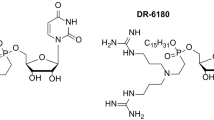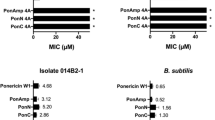Abstract
This study compares the effect of cyclic R-, W-rich peptides with variations in amino acid sequences and sizes from 5 to 12 residues upon Gram negative and Gram positive bacteria as well as outer membrane-deficient and LPS mutant Escherichia coli (E. coli) strains to analyze the structural determinants of peptide activity. Cyclo-RRRWFW (c-WFW) was the most active and E. coli-selective sequence and bactericidal at the minimal inhibitory concentration (MIC). Removal of the outer membrane distinctly reduced peptide activity and the complete smooth LPS was required for maximal activity. c-WFW efficiently permeabilised the outer membrane of E. coli and promoted outer membrane substrate transport. Isothermal titration calorimetric studies with lipid A-, rough-LPS (r-LPS)- and smooth-LPS (s-LPS)-doped POPC liposomes demonstrated the decisive role of O-antigen and outer core polysaccharides for peptide binding and partitioning. Peptide activity against the inner E. coli membrane (IM) was very low. Even at a peptide to lipid ratio of 8/1, c-WFW was not able to permeabilise a phosphatidylglycerol/phosphatidylethanolamine (POPG/POPE) bilayer. Low influx of propidium iodide (PI) into bacteria confirmed a low permeabilising ability of c-WFW against PE-rich membranes at the MIC. Whilst the peptide effect upon eukaryotic cells correlated with the amphipathicity and permeabilisation of neutral phosphatidylcholine bilayers, suggesting a membrane disturbing mode of action, membrane permeabilisation does not seem to be the dominating antimicrobial mechanism of c-WFW. Peptide interactions with the LPS sugar moieties certainly modulate the transport across the outer membrane and are the basis of the E. coli selectivity of this type of peptides.











Similar content being viewed by others
References
Appelt C et al (2005) Structure of the antimicrobial, cationic hexapeptide cyclo(RRWWRF) and its analogues in solution and bound to detergent micelles. ChemBioChem 6(9):1654–1662
Appelt C et al (2008) Structures of cyclic, antimicrobial peptides in a membrane-mimicking environment define requirements for activity. J Pept Sci 14(4):524–527
Arouri A et al (2009) Peptide induced demixing in PG/PE lipid mixtures: a mechanism for the specificity of antimicrobial peptides towards bacterial membranes? Biochim Biophys Acta 1788(3):650–659
Bagheri M et al (2011) Interaction of W-substituted analogs of cyclo-RRRWFW with bacterial lipopolysaccharides: the role of the aromatic cluster in antimicrobial activity. Antimcirob Agents Chemother 55(2):788–797
Chan WC, White PD (2000) Fmoc solid phase peptide synthesis—a practical approach. Oxford University Press, Oxford
Chan DI et al (2006) Tryptophan- and arginine-rich antimicrobial peptides: structures and mechanisms of action. Biochim Biophys Acta 1758:1184–1202
Dathe M et al (1996) Peptide helicity and membrane surface charge modulate the balance of electrostatic and hydrophobic interactions with lipid bilayers and biological membranes. Biochemistry 35(38):12612–12622
Dathe M et al (2002) General aspects of peptide selectivity towards lipid bilayers and cell membranes studied by variation of the structural parameters of amphipathic helical model peptides. Biochim Biophys Acta 1558(2):171–186
Dathe M et al (2004) Cyclization increases the antimicrobial activity and selectivity of arginine- and tryptophan-containing hexapeptides. Biochemistry 43(28):9140–9150
Deres K et al (1989) In vivo priming of virus-specific cytotoxic T lymphocytes with synthetic lipopeptide vaccine. Nature 342(6249):561–564
Epand RF et al (2005) Bacterial species selective toxicity of two isomeric alpha/beta-peptides: role of membrane lipids. Mol Membr Biol 22(6):457–469
Epand RF et al (2006) Role of membrane lipids in the mechanism of bacterial species selective toxicity by two alpha/beta-antimicrobial peptides. Biochim Biophys Acta 1758(9):1343–1350
Epand RF et al (2008) Dual mechanism of bacterial lethality for a cationic sequence-random copolymer that mimics host-defense antimicrobial peptides. J Mol Biol 379(1):38–50
Eriksson-Grennberg KG et al (1971) Resistance of Escherichia coli to Penicillins. J Bacteriol 108(3):1210–1223
Farnaud S et al (2004) Interactions of lactoferricin-derived peptides with LPS and antimicrobial activity. FEMS Microbiol Lett 233(2):193–199
Fishov I, Woldringh CL (1999) Visualization of membrane domains in Escherichia coli. Mol Microbiol 32(6):1166–1172
Friedrich CL et al (2000) Antibacterial action of structurally diverse cationic peptides on gram-positive bacteria. Antimicrob Agents Chemother 44(8):2086–2092
Hancock REW (1999) Host defense (cationic) peptides—what is their future clinical potential? Drugs 57(4):469–473
Hancock RE, Sahl HG (2006) Antimicrobial and host-defense peptides as new anti-infective therapeutic strategies. Nat Biotechnol 24(12):1551–1557
Hilpert K et al (2005) High-throughput generation of small antibacterial peptides with improved activity. Nat Biotechnol 23(8):1008–1012
Hirakura Y et al (2002) Specific interactions of the antimicrobial peptide cyclic beta-sheet tachyplesin I with lipopolysaccharides. Biochim Biophys Acta 1562(1–2):32–36
Junkes C et al (2008) The interaction of arginine- and tryptophan-rich cyclic hexapeptides with Escherichia coli membranes. J Pept Sci 14(4):535–543
Keller S et al (2006) Monitoring lipid membrane translocation of sodium dodecyl sulfate by isothermal titration calorimetry. J Am Chem Soc 128(4):1279–1286
Laughrey ZR et al (2008) Carbohydrate-pi interactions: what are they worth? J Am Chem Soc 130(44):14625–14633
Lehrer RI et al (1988) Concurrent assessment of inner and outer membrane permeabilization and bacteriolysis in E. coli by multiple-wavelength spectrophotometry. J Immunol Methods 108(12):153–158
Lohner K et al (2008) Liposome-based biomembrane mimetic system: implications for lipid-peptide interaction. Adv Planar Lipid Bilayers Liposomes 6:103–137
Matsumoto K et al (2006) Lipid domains in bacterial membranes. Mol Microbiol 61(5):1110–1117
Mosmann T (1983) J Immunol Methods 65:130–134
Nicolas P (2009) Multifunctional host defense peptides: intracellular-targeting antimicrobial peptides. FEBS J 276(22):6483–6496
O′Leary WM et al (1988) Gram-positive bacteria. In: Ratledge C, Wilkinson SG (eds) Microbial lipids. Academic Press, London, pp 117–201
Park KH et al (2008) Bacterial selectivity and plausible mode of antibacterial action of designed Pro-rich short model antimicrobial peptides. J Pept Sci 14(7):876–882
Pearson DA et al (1989) Trialkylsilanes as scavengers for the trifluoroacetic acid deblocking of protecting groups in peptide synthesis. Tetrahedron Lett 30:2739–2742
Ramjeet M et al (2005) Truncation of the lipopolysaccharide outer core affects susceptibility to antimicrobial peptides and virulence of Actinobacillus pleuropneumoniae serotype 1. J Biol Chem 280(47):39104–39114
Schindler PRG, Teuber M (1975) Action of Polymyxin-B on bacterial membranes—morphological changes in cytoplasm and in outer membrane of Salmonella typhimurium and Escherichia coli-B. Antimicrob Agents Chemother 8(1):95–104
Schnorrenberg G, Gerhardt H (1989) Fully automatic simultaneous multiple peptide synthesis in micromolar scale—rapid synthesis of series of peptides for screening in biological assays. Tetrahedron 45:7759–7764
Schuhmann E, Taubeneck U (1969) Sabile L-formen verschiedener Escherichia coli-Stämme. Zeitschrift Allg Mikrobiol 9:297–313
Seelig J (1997) Titration calorimetry of lipid-peptide interactions. Biochim Biophys Acta 1331(1):103–116
Thomas CJ et al (1999) Surface plasmon resonance studies resolve the enigmatic endotoxin neutralizing activity of polymyxin B. J Biol Chem 274(42):29624–29627
Vanounou S et al (2003) Phosphatidylethanolamine and phosphatidylglycerol are segregated into different domains in bacterial membrane. A study with pyrene-labelled phospholipids. Mol Microbiol 49(4):1067–1079
Wessolowski A et al (2004) Antimicrobial activity of arginine- and tryptophan-rich hexapeptides: the effects of aromatic clusters, D-amino acid substitution and cyclization. J Pept Res 64(4):159–169
Wickens HJ et al (2000) Flow cytometric investigation of filamentation, membrane patency, and membrane potential in Escherichia coli following ciprofloxacin exposure. Antimicrob Agents Chemother 44(3):682–687
Wiegand I et al (2008) Agar and broth dilution methods to determine the minimal inhibitory concentration (MIC) of antimicrobial substances. Nat Protoc 3(2):163–175
Wilkinson SG (1988) Gram negative bacteria. In: Ratledge C, Wilkinson SG (eds) Microbial lipids. Academic Press, London, pp 299–488
Acknowledgments
We are very grateful to Heike Nikolenko (FMP) and Damian Rivett (King’s College London) for the support in biological experiments. Sandro Keller (University of Kaiserslautern) is thanked for his contributions to the ITC studies. Jürgen Streich (IZW) is thanked for his support in the statistical analysis of MIC data. Martin Schulze (IFN, Schoenow/Bernau), Katrin Müller, Stephanie Speck (both IZW, Berlin) are thanked for their cooperation in the joint project on antimicrobial peptides. Finally, we are particularly thankful to Sebastian Farnaud (University of Westminster) and James Mason (King’s College London) for their high interest in the work and their efforts to continue our fruitful cooperation. The work was supported by the BMWi grant KF0376991MD6 and a DAAD scholarship (Ch. Junkes).
Author information
Authors and Affiliations
Corresponding author
Additional information
Membrane-active peptides: 455th WE-Heraeus-Seminar and AMP 2010 Workshop.
Rights and permissions
About this article
Cite this article
Junkes, C., Harvey, R.D., Bruce, K.D. et al. Cyclic antimicrobial R-, W-rich peptides: the role of peptide structure and E. coli outer and inner membranes in activity and the mode of action. Eur Biophys J 40, 515–528 (2011). https://doi.org/10.1007/s00249-011-0671-x
Received:
Revised:
Accepted:
Published:
Issue Date:
DOI: https://doi.org/10.1007/s00249-011-0671-x




